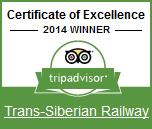 |
|
|
 UK: 0845 521 2910 UK: 0845 521 2910 | |
 USA: 1 8665 224308 USA: 1 8665 224308 | |
 AUS: 1300 654 861 AUS: 1300 654 861 | |
 expert@trans-siberian.co.uk expert@trans-siberian.co.uk | |

Destinations
Email an expert
All of our trips have a pre-arranged schedule. However if you would like to customise your journey, please let us know how by either calling us on 0845 521 2910 or emailing us
Barnaul & the Altai Mountains
Barnaul isn’t why you came all this way – it’s a pleasant-enough Siberian city with nothing special. What’s special is what leads away from Barnaul – the road that leads into the Altai Mountains, Siberia’s most spectacular secret, and where we spend our own vacations. The absence of rail or air connections south of Barnaul has helped keep this secret, and for the moment at least, the Altai remains one of the least-visited wilderness regions on earth… the perfect place for hiking, horse-riding or rafting. The Katun River is one of the best rafting centres in Russia, and a number of raft-centres, campsites and lodges line its banks. A smaller number of the local Asiatic Altai people still live in the area, and may share their cultural traditions with the small number of visitors who take an interest in them – but this is a culture that’s severely endangered, so try to catch it soon. Once you are in the Altai, you may even find the legendary Kingdom of Belovodia… legend says that the doorway to this alternative dimension opens once every thirty-three years, and only seven people can enter… but the seventh has to come back to show six more in thirty-three years time.
The Altai Mountains
This is the “good stuff” which you thought would be in Novosibirsk, but isn’t there. If you are looking for the “real Siberia” of little mountain villages with the odd goat wandering in the road and a few chickens running-around, then the Altai is where you should head. But be warned, Russians themselves have started to realize that the Altai is their “own little Switzerland”, and are starting to head there too – you need to press on into the mountains to get beyond the landcruiser crowd. There aren’t any “sights” to see, because what there is to see is all around you – marvelous mountain landscapes, clean fast-flowing mountain rivers (and rafters taking trips along them), forest pinewood lodges to stay in, and locally organically-grown food. It’s also ethnically the area of the Altaic people – not one ethnic grouping, but an amalgam of several different Asiatic peoples who once lived here, and have been largely thrown-together by the workings of the soviet state which “collectivized” them. Even so, there are few of them left – most of the young people here leave to find jobs in the big cities.
Don’t miss in the Altai…
Generally ...
You’ll need to get a long way into the mountains before you can shake-off the shards of soviet development. Gorno-Altaisk is nominally the region’s capital (it hasn’t got either rail or air connections, everything’s closed-down since the end of the USSR) but is a grim concrete dump that you’ll want to bypass. Biysk is worth a short stop along the road, as it was once a pretty town… it was the end of the camel highway through the Altai Mountains that used to bring “brick tea” (the cheapest sort) to Siberia from China, along with other goods. But Biysk itself was a rather civilized place where there were even outposts of major German department stores (although the building is now boarded-up and for sale – it’s been empty for years).
Manzherok
Manzherok is where the topography starts to get interesting and you feel you’ve arrived in the mountains themselves However, there’s quite an explosion of tour-camps around here, and it’s worth going further to put mass tourism behind you. Along the road is Aya where the thermal warm springs have attracted visitors since the C19th – the tiny town is reached via a rather rickety bridge.
Chemal
Chemal is really the best place to head for – a real “town” along the river valley, and officially the “last inhabited point” (ie it has electricity and a sub-post-office) – although people do live in isolated hamlets further along the river. There are multiple horse-riding and rafting options available here, along with the chance to see some ancient cliff-paintings made by primitive societies living in this warm micro-climate… where even melons and lemons can be encouraged to grow in the middle of Siberia.











